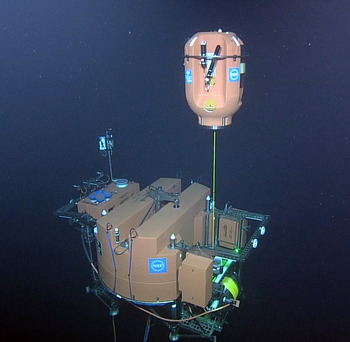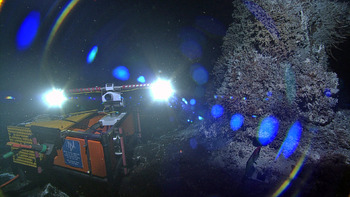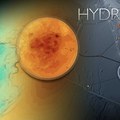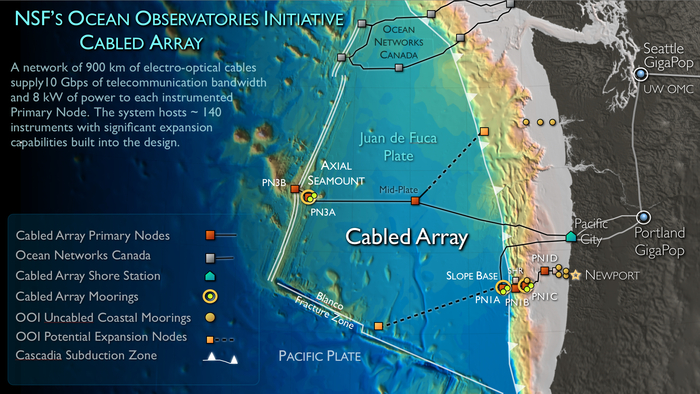
Since the late summer, 2015, each of the three cabled Shallow Profiler Mooring winched science pods have made >7000 cycles from 600 ft water depth to just beneath the oceans' surface. Real-time command and control of these systems through the Internet provides response capabilites such that the science pods can be stopped to take key measurements in response to events that include the passing over of biologically-rich thin layers. Credit: University of Washington, NSF-OOI/ROPOS, V15.

A new high definition camera was installed at the hydrothermal vent called 'Mushroom' in the ASHES hydrothermal field atop Axial Volcano. The camera, built by the UW Applied Physics Lab, was tested today and streamed live HD imagery >300 miles back to shore from a water depth of >5000 m. Credit: Credit: NSF-OOI/UW/ISS; Dive R1835; V15.
The OOI cabled observatory (Cabled Array) provides high power (10 kV, 8kW) and bandwidth to >>100 instruments on the seafloor and throughout the water column at key study sites: Southern Hydrate Ridge, Axial Seamount, and the Endurance Array Newport Line. Power and bandwidth are distributed from the cables through a total of seven Primary Nodes: two each at Hydrate Ridge, Axial Seamount, and on the Newport Line. The Mid-Plate node in the middle of the Juan de Fuca plate is a placeholder node with minimal internal electronics yet available for future network expansion.
Hydrate Ridge: methane seeps
Southern Hydrate Ridge is an important observatory site to
- define the temporal evolution of methane hydrate systems in response to seismic events,
- determine material fluxes from the seafloor and impacts on overlying ocean chemistry, and
- understand biogeochemical coupling associated with gas hydrate formation and disassociation.
The real-time interactive capabilities of the cabled observatory are critical to studying gas hydrate systems because many of the key processes may occur over short time scales and will require adaptive response and sampling capabilities.
Axial Seamount: an active volcano
Axial Seamount on the Juan de Fuca Ridge is the most magmatically robust volcano on the spreading center having erupted in 1998, 2011, and most recently in April 2015. It hosts numerous active hydrothermal vent fields and is one of the best-studied volcanoes along the global mid-ocean ridge. As part of the OOI cabled observatory, high power and bandwith are utlized at the summit of Axial Seamount to communicate and power a diverse array of sensors to monitor the inflation and deflation of the volcano during the injection of magma, hydrothermal activity, and the rich biological communities at the site. Real-time high definition video provide spectacular views of tubeworms, crabs, and other animals that thrive at the hyrothermal vents. Other sensors include in situ mass spectrometers, seismometers to monitor earthquake activity, temperature and chemical probes, fluid and DNA samplers, and pressure-tilt meters.
The Endurace Array Newport Line: coastal upwelling region
The coastal OOI Endurance Array monitors cross-shelf and along-shelf variability in the coastal upwelling region off the Oregon and Washington coasts. This array consists of a mooring and seafloor instrumented line off Newport, OR, connected to the Cabled Array, and another moored line off Gray's Harbor, WA. To provide synoptic, multi-scale observations of the eastern boundary current, the two cross-shelf moored array lines, each with three instrumented sites (at 25 m, 80 m, and 600 m water depth), are supplemented by six gliders patrolling the coastal region. The Endurance Array Newport Line extends the reach and capability of the cabled observatory infrastructure into the coastal environment, while simultaneously providing the transformative high-power, high-bandwidth capabilities to the Coastal Scale component of the OOI.



